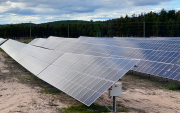Canadians like to think of their electricity generally being fairly clean. After all, some provinces such as Quebec, Manitoba and B.C. have systems that emit almost no greenhouse gases. It'll surprise some of you then that we found only one per cent of Canada's electricity comes from sources that are both low-impact and renewable.
Our report, Green Power Programs in Canada — 2007, researched and written for Environment Canada, found that despite green power nearly doubling from 2003 to 2007, most of our electricity still comes from polluting or high-impact sources.
While there are different opinions on what defines "green" power, generally it refers to electricity that has two characteristics: 1) It is produced from renewable sources and 2) Its production has low adverse impacts on the environment, human health and communities.
More than 60 per cent of Canada's electricity comes from large hydro systems, which tend to pass the first characteristic, but some of our historic development failed on the second — particularly with respect to First Nation communities.
Overall, Canada's electricity is much cleaner than the American system, which is dependent on coal for more than half of its electricity generation. However, electricity production was still responsible for more than 17 per cent of Canada's greenhouse gas emissions in 2007, as well as being a major source of poisonous sulphur dioxide and mercury released into our air. There remains a big opportunity for green power to clean up our electricity system, particularly in provinces that are still heavily reliant on coal.
While green power can provide environmental and economic benefits to individuals and communities, it often costs more in the short-term than many conventional power alternatives. Companies, utilities and governments that recognize the benefits of green power have developed policies and programs to offer, encourage or require green power. Environment Canada has contracted the tracking of the success of these programs in 2002, 2003 and 2007.
We are just publicly releasing the 2007 report and, although a lot has changed since then, there's still a lot to be learned from looking back.
Green power was growing quickly in 2007, and has continued to do so since the report was completed. By the end of 2007 more than 5.6 TWh of electricity were produced from low-impact, renewable energy sources, enough to power almost one million homes in Canada. One of the reasons for this has been a significant increase in provinces making commitments to green power and enacting policies to achieve them.
One key lesson we learned while doing this research is that while voluntary markets have been important in stimulating green power development in Canada, the trend has been toward more provincial regulation and policy. In fact, several of the voluntary green power programs in place in 2003 didn't exist in 2007.
 Since this report was completed, even more provincial steps have been taken (most notably Ontario's Green Energy Act), and the Federal government's ecoENERGY for renewable power continued to play an important role in seeing green power continue to grow in Canada despite the global economic downturn.
Since this report was completed, even more provincial steps have been taken (most notably Ontario's Green Energy Act), and the Federal government's ecoENERGY for renewable power continued to play an important role in seeing green power continue to grow in Canada despite the global economic downturn.
However, three important issues that we identified in 2007 remain important today. Firstly, the federal government's production incentive will no longer be available in 2011. Secondly, it remains to be seen whether provinces and utilities will perceive their own targets and goals as maximums or as points from which to continue to build once they are met. Finally, some very significant decisions will be made in the near future in many provinces with respect to grid infrastructure and replacing retiring power plants.
Canadians like to think of their electricity as clean and green. Unfortunately, low-impact renewable sources still only represent a very small proportion of our electricity sources despite their continued growth. We look forward to the day when low-impact renewable sources outweigh our collective dependence on fossil fuels for electricity. As we found in our report, that day will only come when governments, utilities and individuals step forward to make it happen.










